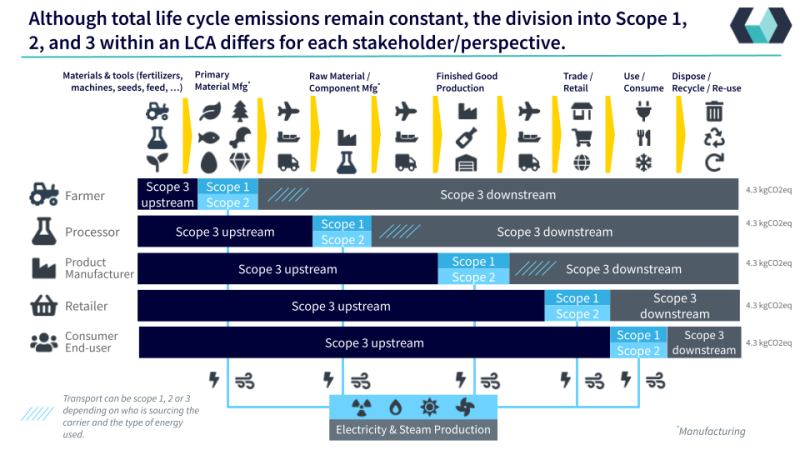Carbon Footprint
IMDE Definition for Carbon Footprint:
- Carbon Footprint is a LCA indicator related to Global Warming caused by greenhouse gasses.
- Represents the emissions of all greenhouse gases (GHGs) expressed as CO2 emissions.
- In the Carbon Footprint conversion of all GHGs to CO2 equivalent a standardized Global Warming Potential (GWP) table based on a 100-year time horizon is used.
- The Value Unit for the Carbon Footprint indicator is kilograms of carbon dioxide equivalent (kgCO2eq)
- The emissions can be emitted directly or indirectly
- Emissions are expressed as a gross emission value (so without for example compensation)
Application
The Carbon Footprint can be applied to multiple entities:
- Legal Entity: Such as corporations or organizations. The Carbon Footprint is measured over a specified period, typically per calender year or financial year, since Carbon Footprint date on Legal Entity level is used in ESG reporting.
- Location: Specific geographical sites or operational areas within the organization, specified per period, typically a calendar year or financial year
- Item: Physical Products or goods
Items will have Carbon Footprint per Material Use Category
For items, the Carbon Footprint is specified per Material Use Category:
- The Product: (consumable, disposable, and durable). The default measurement unit is per kilogram (kg) of the product, but alternative units may be used depending on the product's nature (e.g., per consumer unit, per portion, per liter, per piece, per meter, per m2 etc.).
- The Packaging: Measured per Trade Unit, which can be a Consumer Unit, Handling Unit, Shipping Unit, or Transport Unit.
Combining both will result in the Carbon Footprint per Trade Item (Trade Item = Product + Packaging)
And is accompanied by a LCAterm and Geographic Location info
When exchanging the Carbon Footprint value for individual items, it is essential to associate each value with a specific LCAterm (Life Cycle Assessment Term) and the related geographic location. This practice is analogous to how pricing is tied to an Incoterm in commercial transactions. The LCAterm provides crucial context by defining the scope and boundaries of the lifecycle assessment for that item. It includes details such as the stages of the product lifecycle covered (e.g., from raw material extraction to end-of-life disposal), the geographical scope, and any specific processes or stages that are included or excluded in the calculation.
Providing a Carbon Footprint value without an accompanying LCAterm would be similar to stating a price without specifying the associated Incoterm; it lacks the necessary context for interpretation and comparison. Just as Incoterms clarify terms of trade, LCAterms ensure that the reported Carbon Footprint values are clear, consistent, and meaningful, facilitating accurate comparisons and informed decision-making. It is therefore imperative that each Carbon Footprint value reported is accompanied by a clearly defined LCAterm to ensure transparency and reliability in sustainability reporting.
Why not use Scope 1,2,3 in LCA data exchange?
Scope 1, 2, and 3 is a perspective concept part of the Greenhouse Gas Protocol, and the values are therefore dependent on the perspective. The direct emissions of one company (Scope 1) can be the indirect emissions of another company (Scope 3) within the lifecycle of a single product. And Scope 3 is split into upstream (emissions by others before me in the life cycle) and downstream Emissions by other companies or consumers after my operations in the life cycle) in every perspective. So, there isn't something like a Scope 3 value per product.
